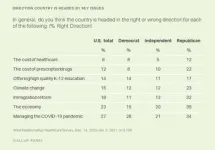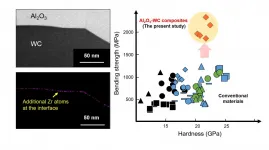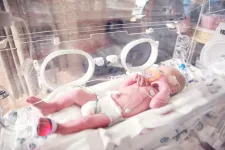Micro-brewing goes more micro
2021-01-28
(Press-News.org) A PhD student and 'beer scientist' has inadvertently discovered a way to conduct extremely small-scale brewing experiments, potentially leading to better beer.
It came about when University of Queensland PhD candidate Edward Kerr hit a hurdle when he completed a beer brewing experiment for a paper.
"I was looking at barley protein changes during the mashing stage of beer brewing, when one of the paper's reviewers asked if the changes were caused by temperature or time spent mashing the barley," Mr Kerr said.
"It was a good question, but to find out I'd need to brew all over again, with an instrument that would hold at least 23 litres of brew, including five kilograms of malt for each brew - it would have taken another three months.
"To be honest, I was feeling a little lazy, so decided to see if I could do the same experiment on a much smaller scale.
"The result was surprising - I found that I could replicate the beer brewing process using only a single barley seed in a 1.5 millilitre tube."
Mr Kerr said these kinds of experiments would previously have occurred at much larger, ingredient-intensive scales of about 50 to 100 litres.
"This is because it has always been thought that testing how barley varieties perform in brewing had to be done at a similar scale to actual beer production," he said.
"When breweries are trying out a new beer recipe they also want to make enough of it to be able to easily test it by drinking.
"But this discovery brings together large-scale industrial beer producers and research scientists, who are used to high precision and sensitivity."
Mr Kerr's supervisor, Associate Professor Benjamin Schulz, said the method could speed up the quality testing of newly-bred barley varieties.
"Barley breeding focuses on increasing productivity and resistance to stresses such as heat and disease, but doesn't take into account the quality of the barley until late in the process," Dr Schulz said.
"And that's a pretty challenging thing to test for, simply because of the scale previously required.
"Now that we only need a tiny amount of malted barley, we can quickly and easily ensure new varieties are of high quality.
"This could encourage breweries to be adventurous with their brewing conditions and may very well lead to new styles of beer.
"Hopefully it'll also help ensure we have a supply of high-quality Australian barley into the future, given ongoing stresses of drought and climate change.
"We're also hoping to use this approach in undergraduate practical courses in chemical engineering associated with the upcoming UQ Nanobrewery - it's a great opportunity to bring process experimentation and optimisation into the student experience.
"But while 1.5 millilitres is definitely more convenient, quicker and cheaper, it's a little small for a refreshing after-work beer."
INFORMATION:
The research has been published in Scientific Reports (DOI: 10.1038/s41598-020-80442-7).
Mr Kerr's PhD project is supported by Newstead Brewing Co. and Advance Queensland.
[Attachments] See images for this press release:

ELSE PRESS RELEASES FROM THIS DATE:
2021-01-28
WASHINGTON, D.C. and SAN DIEGO, CA -- In his inaugural address, President Joe Biden vowed that "help is on the way" to a nation grappling with a pandemic that has already claimed over 420,000 lives and counting. However, despite the promise of a better future, a new survey from West Health and Gallup finds Americans remain largely skeptical that issues as varied as managing the COVID-19 crisis, lowering healthcare costs, improving the economy, fixing immigration and addressing climate change, will improve anytime soon.
The findings from the monthly West Health-Gallup U.S. Healthcare Study are based on a ...
2021-01-28
Pioneering research into how our bodies manufacture the cells that make blood has moved us closer to regrowing tissues and organs. The findings also may let doctors grow the cells for transplantation into people to battle cancer, blood disorders and autoimmune diseases.
Researcher Karen K. Hirschi, PhD, of the Department of Cell Biology and the Robert M. Berne Cardiovascular Research Center at the University of Virginia School of Medicine, has developed a simple and efficient way to generate "hemogenic endothelial cells." These cells are the first step in the production line of blood cells, and Hirschi's new findings provide a blueprint for creating them outside the body.
"By studying how hemogenic endothelial cells develop normally, we gain insights needed ...
2021-01-28
Ceramic matrix composites (CMCs) are incredibly strong materials used in jet engines, gas turbines, and cutting tools for nickel superalloys. Aluminum oxide (Al2O3) is hard and chemically inert, and tungsten carbide (WC) is used as a superhard material, but past efforts to create an Al2O3-WC CMC yielded unsatisfactory results. Recently, a study by Japanese scientists, published in Scientific Reports, shows that adding zirconium atoms results in improved Al2O3-WC CMCs.
Given the potential utility of Al2O3-WC CMCs as superhard materials, researchers around the world have tested several formulations to identify one with a high bending strength, which is a measure of the physical stress a material can be subjected to before it becomes permanently bent or broken. Previously, ...
2021-01-28
In a first-of-its-kind study, researchers discovered that light pollution leads to more than just wasted energy and washed-out starlight--it can increase the likelihood of a preterm birth by almost 13%. Laura Argys, professor of economics at the University of Colorado Denver, collaborated with scientists at Lehigh University and Lafayette College to produce this study.
Skyglow, the brightness of the night sky apart from discrete light sources such as the moon and visible stars, is one of the most pervasive forms of light pollution. When you have increased artificial brightness at night, coming from sources like streetlamps, outdoor advertising, and buildings, it reduces your ability to see the dark ...
2021-01-28
Aging and lifestyle-related metabolic imbalances, such as hyperglycemia, hyperlipidemia, and oxidative-stress, cause the accumulation of advanced glycation end products (AGEs), including pentosidine (PEN, crosslinked type) and carboxymethyl-lysine (CML, non-crosslinked type). Osteoporosis is a widespread metabolic skeletal disease characterized by diminished bone mineral density (BMD) or bone strength, which increases the risk of fractures.
To date, the association of PEN and CML with osteoporotic fracture has been reported, and the accumulation of AGEs in bone ...
2021-01-28
When it comes to drones, the Singapore public is not as keen for them to be used to provide services around their living spaces, finds a study by researchers at the Nanyang Technological University, Singapore (NTU Singapore). However, they are more accepting of drones being used in areas like recreational spots or industrial areas.
There is growing global interest in the use of drones to provide a range of applications - from building inspection to last mile commercial delivery - that promise productivity gains and cost reductions.
In Singapore, the use of drones is picking up, with the government adopting them for various projects in the Smart Nation drive, where technology ...
2021-01-28
Cambridge, Massachusetts - They may be the youngest astronomers to make a discovery yet.
This week, 16-year-old Kartik Pinglé and 18-year-old Jasmine Wright have co-authored a peer-reviewed END ...
2021-01-28
Across many animal species there is great evolutionary pressure on males, who often engage in combat for the rights to copulation. This phenomenon, called sexual selection, often ends up favoring males with larger weapons, such as horns or pincers. Interestingly, scientists have noted that males endowed with smaller weapons adopt alternative reproductive tactics in some species. For example, instead of fighting other more powerful males, they may try to sneak around or disperse in search of a lonely female.
Variability in sexual behavior according to a male's weapon size has been widely studied. However, it's worth noting that bigger is not always better. Though larger weapons usually help in fights for reproductive rights, they can also be ...
2021-01-28
Blood is vital to life, and a healthy body replenishes worn-out blood cells with new ones throughout one's lifetime. If something goes wrong with this process, serious illness will result.
Researchers from the National University of Singapore (NUS) have now discovered a mechanism controlling the replenishment of blood cells, which could have relevance for new treatments for blood cancers and other blood-related diseases.
The international research team, helmed by Dr Akihiko Numata while he was a Postdoctoral Fellow in the laboratory of Professor Daniel Tenen of the Cancer Science Institute of Singapore and Yong Loo Lin School of Medicine ...
2021-01-28
Countries around the world are seeing a surge in the number of computer science students. Enrolment in related university programs in the U.S. and Canada tripled between 2006-2016 and Europe too has seen rising numbers. At the same time, the age to start coding is becoming younger and younger because governments in many different countries are pushing K-12 computer science education. Despite the increasing popularity of computer programming, little is known about how our brains adapt to this relatively new activity. A new study by researchers in Japan has examined the brain activity ...
LAST 30 PRESS RELEASES:
[Press-News.org] Micro-brewing goes more micro





